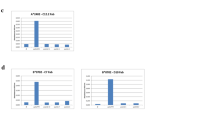Summary
The transfection of murine SP1 tumor cells with the hemagglutinin (HA) gene of influenza virus results, after fluorescent-activated cell sorting (FACS), in the selection of high-HA-expressing cell lines called H4A and H4B. Both lines fail to grow in syngeneic animals at doses that result in 100% tumor take of non-transfected tumor cells. Both grow in immunosuppressed mice. SP1 and H4A or H4B cells express few class I major histocompatibility complex (MHC) antigens but do express class II IAk antigens. H4A or H4B cells engender a cytotoxic T lymphocyte (CTL) response but cannot protect against a challenge with SP1 cells. This CTL response is inhibited by anti-CD4 but not anti-CD8 antibodies. Using FACS, we were able to select a population (called H5AK5) with high class-I MHC antigen expression. Like H4A and H4B, H5AK5 cells fail to grow in syngeneic animals but do grow in immunosuppressed mice. However, unlike H4A or H4B, H5AK5 can induce protection against a challenge with 1 × 105 SP1 cells. These studies indicate that the immunogenicity ofHA-transfected SP1 cells may correlate with the cell-surface expression of class II MHC antigens. However, HA-expressing SP1 cells seem able to induce a protective response against a parent SP1 cell challenge only if they also express class I MHC antigens. This view is supported by the observations that SP1 cells expressing murine interleukin-2 do not express class I MHC antigens, fail to grow in syngeneic animals, do grow in immunosuppressed mice but do not protect against a challenge with parental SP1 cells.
Similar content being viewed by others
References
Carlow DA, Kerbel RS, Feltis JT, Elliott BE (1985) Enhanced expression of class I major histocompatibility complex gene (Dk) products on immunogenic variants of a spontaneous murine carcinoma. J Natl Cancer Inst 75: 291
Carlow DA, Kerbel RS, Elliott BE (1989) Failure of expression of class I major histocompatibility antigens to alter tumor immunogenicity of a spontaneous murine carcinoma. J Natl Cancer Inst 81: 759
Elliott BE, Carlow DA, Ivimey L, Arnold M, Hampton N, Bosman P (1987) In situ augmentation of class I major histocompatibility antigen expression on immunogenic variants of a spontaneous murine mammary carcinoma. Cancer Res 47: 4915
Fearon ER, Itaya T, Hunt B, Vogelstein V, Frost P (1988) Induction in a murine tumor of immunogenic tumor variants by transfection with a foreign gene. Cancer Res 48: 2975
Graham FL, van der Eb AJ (1973) A new technique for the assay of infectivity of human adenovirus 5 DNA. Virology 52: 456
Itaya T, Hunt B, Frost P (1989) Retention of immunogenicity after X-irradiation of mouse colon cells expressing the transfected influenza virus hemagglutinin gene. Clin Immunol Immunother 28: 248
Janeway CA, Carding S, Jones B, Murray J, Portoles P, Rasmussen R, Rojo J, Saizawa K, West J, Bottomly K (1988) CD4+ T cells: specificity and functions. Immunol Rev 101: 39
Janis E, Kaufmann SE, Schwartz RH, Pardoll DM (1989) Activation of gamma/delta T cells in the primary immune response to mycobacterium tuberculosis. Science 244: 713
Karasuyama H, Melchers F (1988) Establishment of mouse cell lines which constitutively secrete large quantities of interleukin 2, 3, 4 or 5, using modified cDNA expression vectors. Eur J Immunol 18: 97
Karasuyama H, Tohyama N, Tada T (1989) Autocrine growth and tumorgenicity of interleukin 2-dependent helper T cells transfected with the IL-2 gene. J Exp Med 169: 13
Keene JA, Foreman J (1982) Helper activity is required for the in vivo generation of cytotoxic T lymphocytes. J Exp Med 155: 768
Kerbel RS, Waghorne C, Man MD, Elliott B, Breitman ML (1987) Alterations of the tumorigenic and metastatic properties of neoplastic cells is associated with the process of calcium phosphate-mediated DNA transfection. Proc Natl Acad Sci USA 84: 1263
Lake P, Mitchinson NA (1976) Associative control of the immune response to cell surface antigens. Immunol Commun 5: 795
Reed L, Muench H (1938) A simple method for estimating fifty percent endpoints. Am J Hyg 27: 493
Sambrook J, Rogers L, White J, Gething MJ (1985) Lines of BPV-transformed mouse cells that constitutively express influenza virus hemagglutinin. EMBO J 4: 91
Schackert HK, Itaya T, Schackert G, Fearon ER, Vogelstein B, Frost P (1989) Systemic immunity against a murine colon tumor (CT-26) produced by immunization with syngeneic cells expressing a transfected viral gene product. Int J Cancer 43: 812
Simcik W, Frost P, LeGrue SJ (1989) Immunologic characteristics of immunogenic variants induced in the MCA-F murine fibrosarcoma using 1-methyl-3-nitro-1-nitrosoguanidine, 5-aza-2′-deoxycytidine or ultraviolet light. Cancer Res 49: 4192
Swain SL (1983) T cell subsets and the recognition of MHC class. Immunol Rev 74: 129
Tanaka K, Yoshioka T, Bieberich C, Jay G (1987) Role of the major histocompatibility complex class I antigens in tumor growth and development. Annu Rev Immunol 6: 359
Tanaka K, Yoshioka T, Bieberich C, Jay G (1988) Role of the major histocompatibility complex class I antigens in tumor growth and metastasis. Annu Rev Immunol 6: 359
Wiltrout RH, Frost P, Cummings GD (1978) Isotope release cytotoxicity assay with the use of111indium: advantage over chromium-51 in long term assays. J Natl Cancer Inst 49: 169
Wraith DC (1987) The recognition of influenza A virus-infected cells by cytotoxic T lymphocytes. Immunol Today 8: 239
Author information
Authors and Affiliations
Additional information
This work was supported by The Clayton Fund, The Sid W. Richardson Foundation and PHS grants CA 39853 and 41525. Toshiyuki Itaya is a visiting scientist supported by the Smith Education Fund of the Department of Cell Biology. Troy Fiesinger is a summer research investigator sponsored by The University of Texas M. D. Anderson Cancer Center Summer Program for College Students
Rights and permissions
About this article
Cite this article
Itaya, T., Fearon, E., Fiesinger, T. et al. Immunogenicity of a non-class I MHC expressing murine tumor transfected with the influenza virus hemagglutinin or murine interleukin-2 genes. Cancer Immunol Immunother 33, 267–273 (1991). https://doi.org/10.1007/BF01744947
Received:
Accepted:
Issue Date:
DOI: https://doi.org/10.1007/BF01744947




